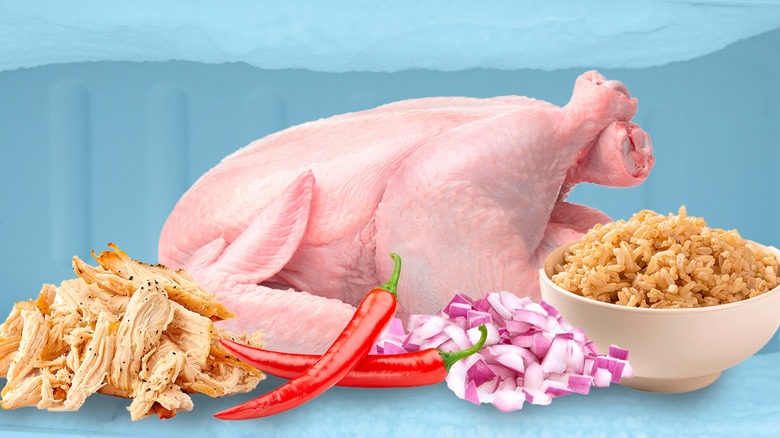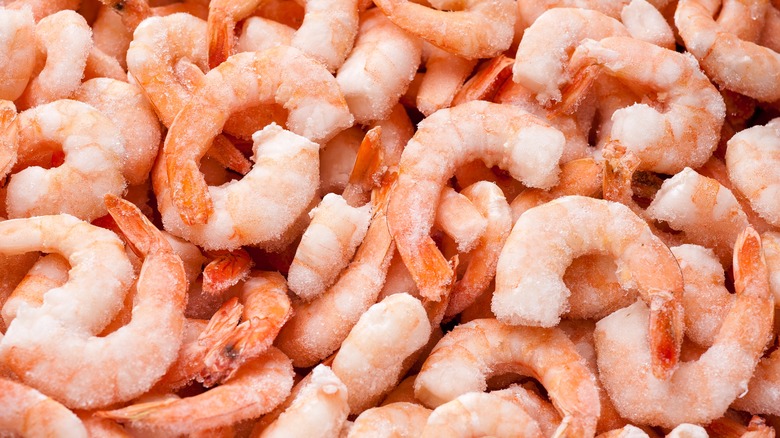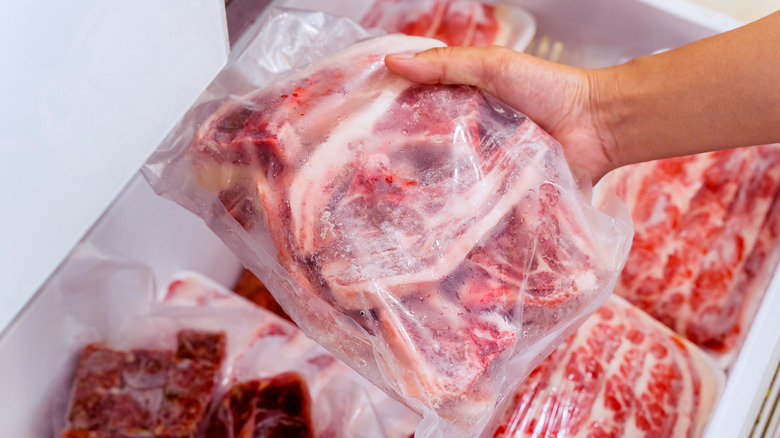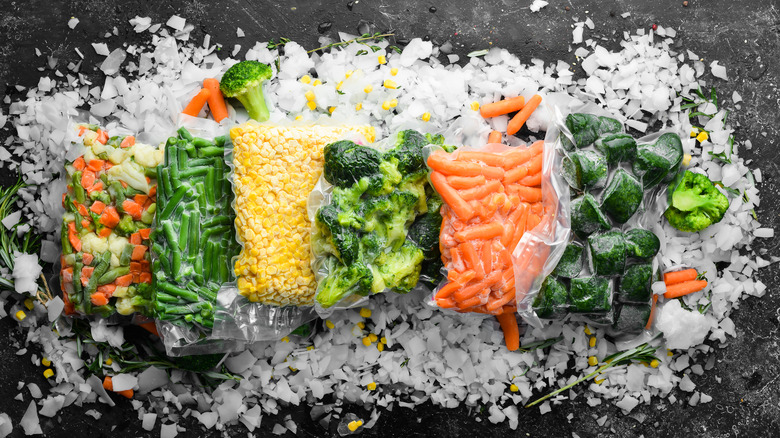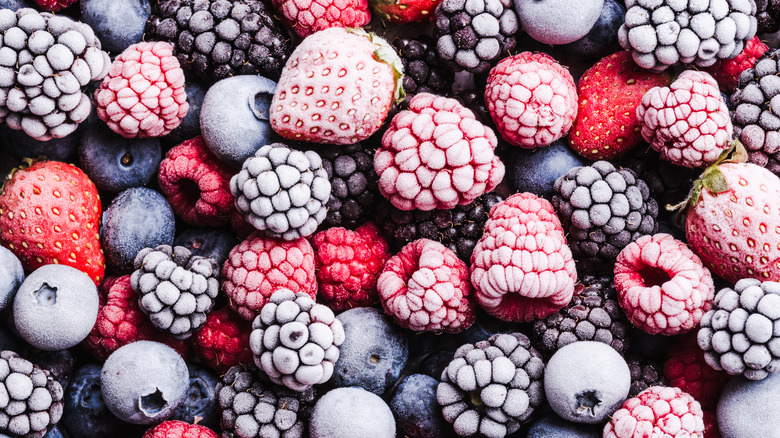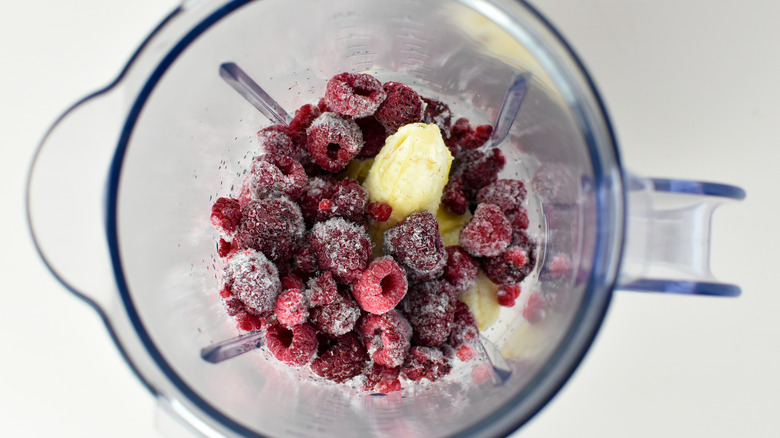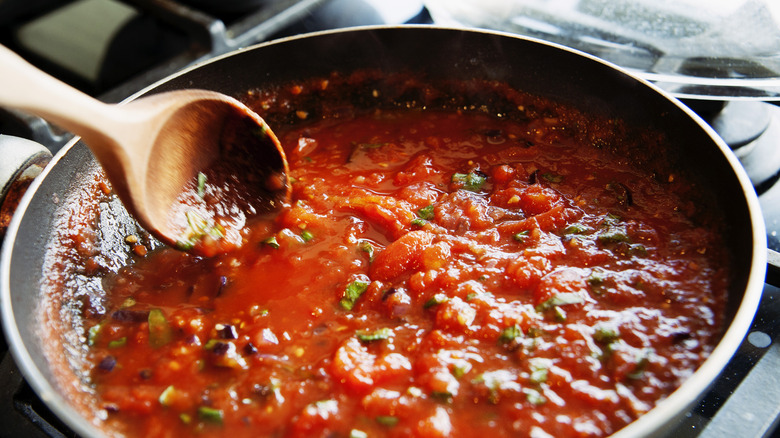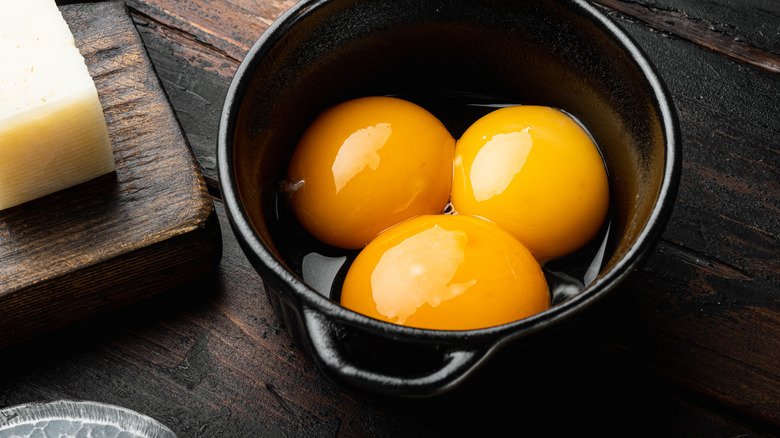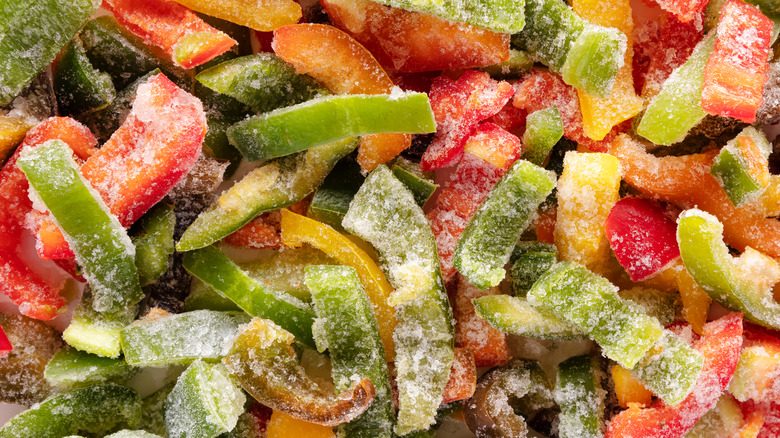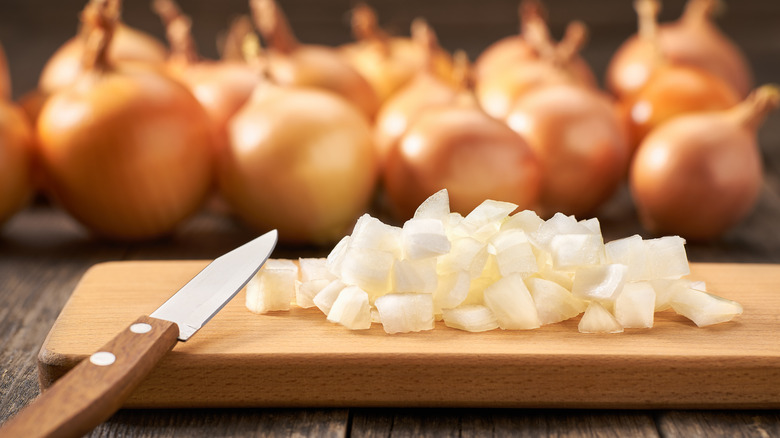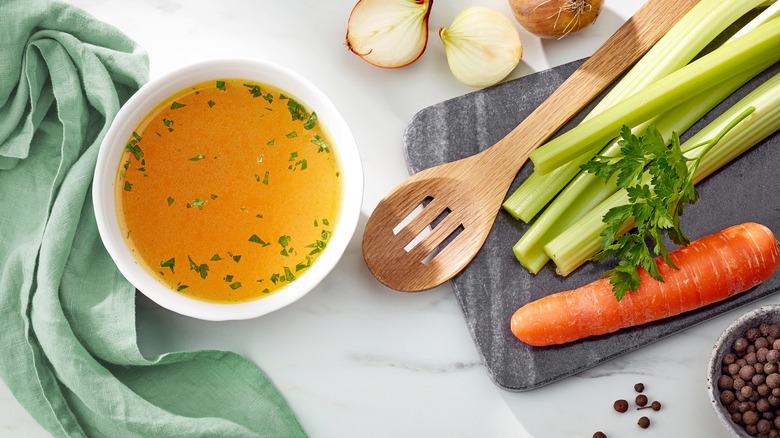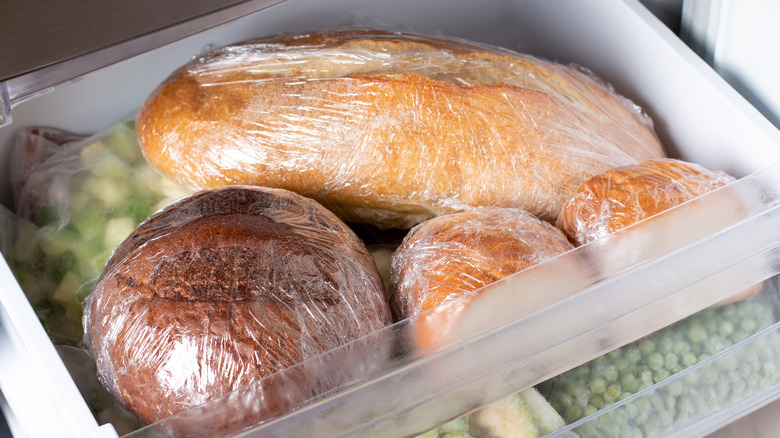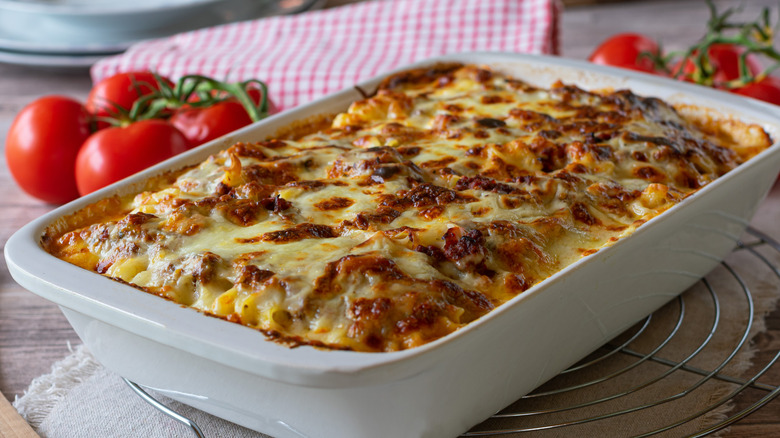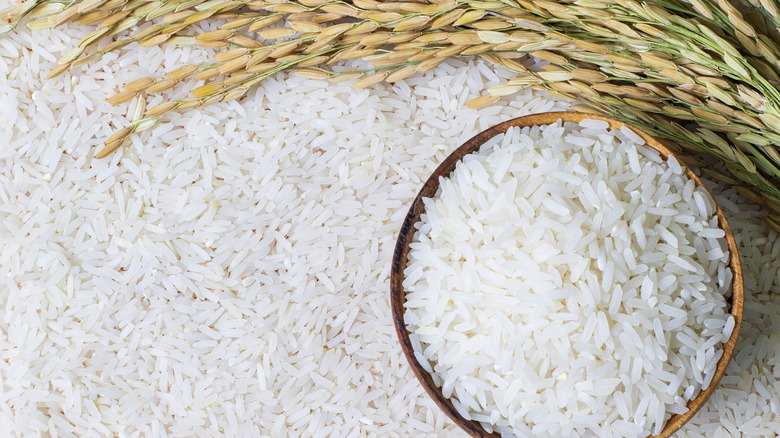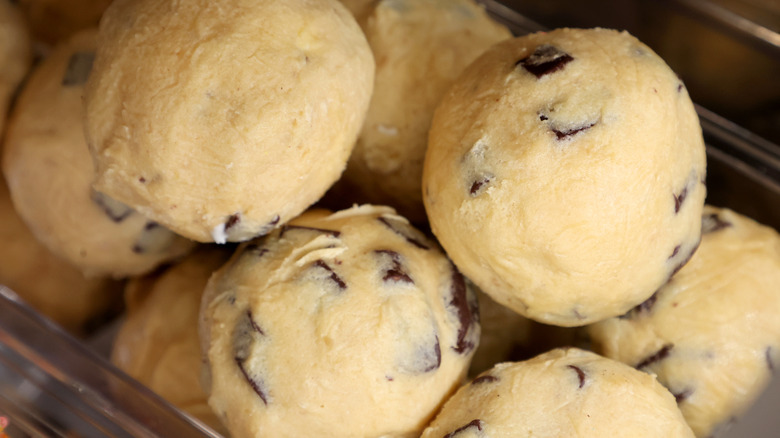14 Foods That Hold Up In The Freezer The Longest
Freezing is a simple, convenient, and reliable method for preserving food. Pulling ready-to-go, homecooked food from the freezer at the last minute is the ultimate timesaving flex, but finding your frozen food afflicted with ice crystals, texture changes, odor absorption, or freezer burn will dampen anyone's enthusiasm at mealtime.
Many foods last for a long time after being put on ice, but some foods hold up better than others, and there's a big difference between "safe to eat" and "good to eat." Avoiding freezing plants with high water content helps, since that water expands when frozen, as well as emulsified foods or dairy products that will separate during the freezing process.
Of course, even the most resilient frozen foods will reheat best when they are properly prepared prior to — and correctly stored during — freezing. It's important to always freeze foods when they are at their peak of freshness, thoroughly cool cooked foods before freezing, and always store your frozen foods in airtight containers. With a little care and strategy, you can preserve the flavor and quality of your favorite foods, save money by buying in bulk, and cook at home in a flash. So which foods hold up in the freezer the longest, and why?
Uncooked fish and shellfish
Freezing seafood is particularly appealing since fresh fish has an astoundingly short shelf life of only one or two days. Unless you live near a fresh fish market and visit it the day or two before your meal, frozen seafood is often the freshest and most available option. In fact, it's estimated that 70% of the seafood consumed in the U.S. has been frozen at some point. Luckily, seafood holds up very well to freezing — it retains its nutritional value, flavor, and freshness even after an extended time in the freezer.
Shrimp stores the longest and will remain good for up to 18 months, followed by lobsters which can be kept frozen for nine to 12 months. Lean fish like cod, haddock, grouper, halibut, tilapia, and bass stay frozen well for up to a year, too. Bivalves like oysters, mussels, oysters, and clams last only about three to six months. Fatty fish such as raw salmon starts to lose some of its quality in as little as two months. While it is safe to eat for up to six months it will lose nutritional value and have a less appealing texture.
For all frozen foods, it's important to choose fresh ingredients and to preserve them at the peak of their freshness, but it is particularly important when dealing with seafood considering how quickly fresh fish goes bad. It's also best not to re-freeze fish that has previously been frozen and thawed.
Large cuts of raw meat
As anyone who's ever needed to defrost a whole turkey leading up to Thanksgiving can attest, whole turkeys and chickens freeze quite well and thaw out flawlessly. When kept frozen, a whole turkey can last an astounding 12 months. The same goes for large cuts of meat like roasts, thick steaks, or briskets.
The biggest challenge with frozen meat is how to prevent freezer burn. All foods — including meat — contain some water, which becomes ice in the freezer. Over time, that ice can sublimate which is basically like evaporation, but the ice skips right over melting and goes from solid form straight into gas form. The upshot is that moisture is lost when those ice crystals sublimate. That's why freezer-burned foods look dry and shriveled. Freezer burn doesn't impact the safety of the food but it does significantly deteriorate the quality. The keys to avoiding freezer-burned meat are patting the meat dry to eliminate surface moisture and removing as much as air possible from the container.
Sublimation is also why large cuts of meat freeze better. The smaller surface area means large cuts are less prone to freezer burn. This holds true for beef, lamb, and pork. Thinner cuts or ground meat freeze well for only three or four months. So next time you see a great deal on whole birds, steaks, or roasts, go ahead and load up — you can keep these raw ingredients on hand and use them for up to a year.
Low-moisture vegetables
There's nothing quite like fresh, in-season produce. Whether it's purchased at the grocer or harvested from your own garden, produce that's in season tastes better and since it's abundant, is wonderfully inexpensive. Preserving the seasonal bounty has been a necessity throughout human history. Now thanks to modern refrigeration, it's easy to do at home in your freezer.
Vegetables keep safely in the freezer for up to 12 months, but it's important to select vegetables with low moisture content (such as broccoli or peas) rather than ones with lots of water (such as iceberg lettuce, cucumbers, or celery). It's prudent to choose vegetables that you plan to serve cooked rather than raw. Since freezing vegetables causes their cell walls to burst, frozen vegetables lose their crunchy texture. However, since vegetables soften during cooking anyway, that change goes almost unnoticed in cooked veggies.
Another consideration when freezing vegetables are the enzymes present in fresh produce. While these enzymes remain active, harvested produce is vulnerable to nutrient loss and color and flavor changes. PennState Extensions explains that you can deactivate these enzymes by blanching vegetables prior to freezing. Blanching doesn't cook them fully, but stops that enzymatic action so you get the highest quality frozen produce. Still, blanching is another reason to freeze vegetables you plan to serve cooked.
Fruit
Fruit stores beautifully in the freezer, but some do last longer than others. Stone fruits like peaches, apricots, and plums last 12 months. Berries also endure for up to a year, but apples and bananas have their best quality for only about six months.
As with vegetables, selecting high-quality fruits at their peak of ripeness is essential for ideal preservation. Although fruit also contains enzymes, unlike vegetables, blanching is not necessary before freezing fruit. Instead, you can slow enzymatic action by applying ascorbic acid (vitamin C) to the fruit before freezing. Even with proper preparation and storage, fruits lose their crunch during freezing and get soft after they're thawed just like vegetables do. To minimize this effect, it's best to freeze fruits that will be cooked in dishes such as peach cobbler or bananas foster or choose fruits that will be served while still frozen. For example, whole frozen grapes or blueberries make a fantastic and refreshing snack eaten straight of out the freezer.
Smoothie mixes
In the same vein as freezing fruit whole and separately, you can use a combination of frozen fruits to create your own quick and easy smoothie mixes. This works best on fruit-packed smoothies, of course, like a mango banana smoothie or an avocado blueberry smoothie. Peel your fruit before freezing it, and slice large fruit like bananas or mangos into chunks for easier blending. Measure out the solid ingredients and package them all together in one freezer bag, sticking to one serving per bag for easy blending. Remove as much air as possible and seal it up.
It's smart to label your bags so you can easily identify what's in each one, especially on a hurried morning. For bonus points, write the recipe on the bag for easy reference. When you're ready for a quick smoothie, toss the contents of the bag into the blender with some ice or your liquid of choice. It couldn't be easier.
Tomato sauce
Since making homemade tomato sauce is a time- and labor-intensive endeavor, it's fortunate that tomato sauce freezes so well. The tomato's natural acidity acts as a preservative that helps the sauce retain its fresh flavor for up to six months in the freezer. When making tomato sauce, you can double or triple the recipe and freeze leftovers as an entire batch. It might be more convenient, however, to freeze it in smaller, pre-measured portions of one or two cups. Freezing in small portions means it'll freeze faster (and therefore freeze better) and makes it easier to thaw out the exact quantity you need later on. Next time you need a quick meal, you'll have a ready-to-go topping for pasta, subs, or chicken Parmesan.
This method works exceptionally well for marinara, bolognese, and other tomato sauces, but it's less reliable for freezing dairy-based sauces, which can result in unpleasant texture and flavor changes.
Egg whites and egg yolks
It happens. Your hollandaise recipe calls for a bunch of egg yolks, and you're left with a surfeit of egg whites. Or you whip up a dreamy batch of merengues and you're left with too many yolks. Luckily you can store these superfluous separated eggs for up to 12 months in the freezer.Freezing egg whites is very straightforward — just separate the egg whites from the yolks, portion them in resealable containers, and place them in the freezer.
Egg yolks require a little more preparation and planning. The texture of a plain egg yolk will be negatively impacted by freezing, but you can overcome this by mixing the egg yolks with a pinch of either salt or sugar before portioning and freezing them. It requires forethought to know whether you will eventually use the yolks for a sweet or savory dish. Remember to label your containers so you remember if yolks were sweetened or salted.
For whites or yolks, consider freezing them individually in ice cube trays. Once they're frozen solid, remove them from the tray and transfer them into a sealable bag. This way, you can defrost the exact number of egg whites or yolks you need. For either egg part, make sure you whisk them after thawing to ensure a uniform texture.
Chiles and sweet peppers
Chiles and sweet peppers can be stored frozen for up to 12 months to extend the flavors of late summer throughout the year. To freeze peppers, wash the outside, slice off the tops, remove the inner membranes, and discard the seeds. Then slice the peppers into strips or dice and spread them out on a tray to freeze. This will keep the pieces from sticking together. Once the pieces are frozen (after about an hour), take them off the tray, seal them in a bag, label them, and place them back in the freezer.
Some peppers such as Hatch or Anaheim chiles are always roasted before they're eaten. For these types of chiles, roast and peel them before freezing. Blistering the chile skin over a flame makes peeling them much easier. Like with thinner-skinned peppers, remove the inner membranes and the seeds from the chiles before freezing.
Chopped onions
One way to save time on food prep is to pre-chop or pre-cook certain ingredients like onions. Chopped raw onions will keep in the freezer for up to eight months, which means you can slice and freeze a big batch of onions and have them ready to go at a moment's notice. You don't even have to let frozen onions thaw before adding them to a recipe! Similar to other plant products, due to texture changes, frozen onions are best served cooked.
You can take your meal prep a step further and freeze a big batch of caramelized onions. While it's not complicated, caramelizing onions requires patience since the process takes more than an hour. If you freeze portions of caramelized onions in advance, you can get that deep, rich flavor caramelized onions are known for in a fraction of the time. Cook your caramelized onions as usual, then allow them to cool thoroughly. Separate them out into small portions for freezing so they're easy to use later.
Whether you're working with cooked or raw onions, be cautious about odor transfer. Onions easily transfer their pungent smell to any container, whether that's an ice cube tray used for portioning or the entire freezer. Protect ice cube trays by lining them with plastic, or use a different tray than you use for ice cubes. Once they're ready for storage, double bag your onions to avoid odor transfer to other foods in the freezer.
Soup stocks and broths
Soup stock is a handy staple that you can make at home in large batches and freeze for use up to three months later. Homemade stock is flavorful and versatile, and it's an excellent way to use meat bones. By freezing your homemade stocks and broths, you can skip buying stock at the grocery store. Homemade stock is much cheaper than storebought, is often more nutritious, and can be customized to your individual preferences.
Since stock is usually made in huge quantities anyway, it's ideal for freezing. Stock may be made in large matches, but it's often used a little at a time, so it's helpful to freeze it in small pre-measured portions. Next time your recipe calls for chicken stock, vegetable broth, or even fish bone broth, you'll be ready with a healthy and affordable homemade version waiting in the freezer that will surely elevate your meal.
Breads and other baked goods
Does anything beat a loaf of fresh baked bread? The delicious aroma and pillowy texture of fresh bread is incomparable — and pretty short-lived. It's hard to eat an entire loaf of bread before it loses quality, but the shelf life of a loaf of bread can be extended by up to three months when it's stored in the freezer.
Air is once again the enemy here, so make sure you remove as much air as you can before sealing your bread up and placing it in the freezer. Freezing preservation is not effective for every type of bread — baguettes and other breads with high air content don't freeze as well as dense breads such as pumpkin bread or rye. Freezing also works well on muffins and dinner rolls.
To freeze bread, slice your loaf (if you didn't buy it pre-sliced) so you can defrost only the number of slices you need. Remove as much air as you can without squishing the bread, and place it in the freezer. When it's time to eat, a slice of bread can be thawed in the microwave on high power for about 15 seconds.
Casseroles
There's a reason lasagnas are standard fare in the frozen food aisle. Casseroles like lasagna, manicotti, and enchiladas, all reheat well after being frozen, and will keep for about three months in the freezer. Since they're already fully assembled and are often frozen in a cooking tray, frozen casseroles provide an easy, complete meal lightning quick.
For the best outcome, freeze casseroles with raw meat, poultry, or shellfish (like lasagna bolognese) should be cooked prior to freezing. Vegetarian casseroles (like kale lasagna, macaroni and cheese, and so on) can be frozen uncooked. If your casserole has a topping like panko or breadcrumbs, freeze it without the topping. When you're ready to cook the casserole, you don't have to let it thaw first. You can put it right in the oven —you just have to cook it a little slower. Increase the original cook time by about half, and lower the temperature slightly. This will give the center enough time to heat through before the edges burn.
Cooked rice
Having a few bags of pre-cooked rice in the freezer can cut down your time in the kitchen significantly, and cooked rice of all types can be frozen for up to six months without deteriorating. Since it will get cooked a little more after it comes out of the freezer, aim for slightly undercooked rice to compensate for that additional cooking time. As with other frozen foods, it's important to let cooked rice cool before you package it and remove as much air as possible from the storage container. Cooked rice will stick together once it's frozen, so it's helpful to place rice in a freezer bag and then press the bagged rice flat. That way, the thin, flattened sheet of rice is easy to break apart into chunks when you're ready to use it. This method also makes portioning the frozen rice simpler.
When it's time to use your frozen rice, there's no need to let it defrost. Rice thawed at room temperature often turns mushy. Instead, take the rice out of the freezer and immediately steam it in either the microwave or on the stovetop with a small quantity of water. Since cooked rice can get drier and harder as it spends time in the deep freeze, frozen rice works well when added to soup dishes. Remember, your rice is already cooked, so you'll add it to soup during the final few minutes of cooking.
Cookie dough
Cookie recipes always seem to yield dozens of cookies, but sometimes you want to bake (and eat) just a few. What's the perfect solution? Freezing your cookie dough, of course! Frozen cookie dough lasts nine to 12 months in the freezer, which is great for making small quantities of cookies at any time. It works best on drop cookies such as chocolate chip cookies because they are individually portioned.
Simply spoon dollops of unbaked dough onto a cookie sheet lined with freezer paper and place them in the freezer. Once the unbaked cookies are frozen, transfer them to an airtight container until you're ready to bake. When it's time, pull out one or two (or dozens) of cookies and bake them as you normally would. You can let them thaw in the refrigerator first, or bake them directly from the freezer. If you bake the frozen dough, adjust your cook time and temperature. Bake the cookies at about 25 degrees Fahrenheit cooler than normal and add a few extra minutes to the time.
